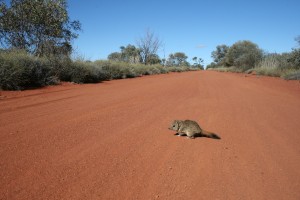 A tiny creature with a penchant for sucking out the brains of its prey is showing signs of a remarkable recovery from the brink of extinction on a remote West Australian reserve.
The brush tailed mulgara, a small carnivorous marsupial, was once common across the arid regions of Australia but in the past quarter of a century has barely been seen.
Predation by cats along with habitat loss and altered fire regimes had decimated numbers of the little known creature leading scientists to fear for the survival of the mulgara.
But new research by the WA Department of Environment and Conservation on Lorna Glen Station, a former pastoral lease and now nature reserve 160 km north-east of Wiluna, has found the malgara is enjoying a population boom.
The fury marsupial, about the same size as a house mouse, is a fierce predator killing its prey with a few quick bites to the head before peeling back its skin and consuming its brain and body.
Scientists monitoring feral cat numbers on the reserve have found multiple signs of the rare mulgara in spinifex and open shrubland and have caught the illusive creature on special camera traps set up to photograph cats.
Senior technical officer with DEC Neil Hamilton said the creatures were known to experience boom and bust cycles and the current boom was good news for the tiny marsupial and its long term survival.
Hamilton who has been working on feral cat research on the reserve for the past decade said a number of other species were also enjoying a revival on Lorna Glen including the red capped robin, splendid fairy wren and western bower bird.
“Other staff have recorded mulgaras in the reserve but our recent survey was the first to record them in any numbers. The number we found was quite intriguing,” Hamilton said.
He said the population boom indicated the animals had enjoyed a good breeding season, unimpeded by cat predation and conditions on the reserve were good.
Lorna Glen, in the eastern goldfields, was purchased by DEC in 2000 and has been restored to its former glory with a number of translocations helping to repopulate the reserve with native animals including bilbies.
Cat control measures have helped restore the old pastoral station and increase biodiversity on the 240 000 ha site.
JANE HAMMOND
A tiny creature with a penchant for sucking out the brains of its prey is showing signs of a remarkable recovery from the brink of extinction on a remote West Australian reserve.
The brush tailed mulgara, a small carnivorous marsupial, was once common across the arid regions of Australia but in the past quarter of a century has barely been seen.
Predation by cats along with habitat loss and altered fire regimes had decimated numbers of the little known creature leading scientists to fear for the survival of the mulgara.
But new research by the WA Department of Environment and Conservation on Lorna Glen Station, a former pastoral lease and now nature reserve 160 km north-east of Wiluna, has found the malgara is enjoying a population boom.
The fury marsupial, about the same size as a house mouse, is a fierce predator killing its prey with a few quick bites to the head before peeling back its skin and consuming its brain and body.
Scientists monitoring feral cat numbers on the reserve have found multiple signs of the rare mulgara in spinifex and open shrubland and have caught the illusive creature on special camera traps set up to photograph cats.
Senior technical officer with DEC Neil Hamilton said the creatures were known to experience boom and bust cycles and the current boom was good news for the tiny marsupial and its long term survival.
Hamilton who has been working on feral cat research on the reserve for the past decade said a number of other species were also enjoying a revival on Lorna Glen including the red capped robin, splendid fairy wren and western bower bird.
“Other staff have recorded mulgaras in the reserve but our recent survey was the first to record them in any numbers. The number we found was quite intriguing,” Hamilton said.
He said the population boom indicated the animals had enjoyed a good breeding season, unimpeded by cat predation and conditions on the reserve were good.
Lorna Glen, in the eastern goldfields, was purchased by DEC in 2000 and has been restored to its former glory with a number of translocations helping to repopulate the reserve with native animals including bilbies.
Cat control measures have helped restore the old pastoral station and increase biodiversity on the 240 000 ha site.
JANE HAMMOND Mulgara population boom after cat control
 A tiny creature with a penchant for sucking out the brains of its prey is showing signs of a remarkable recovery from the brink of extinction on a remote West Australian reserve.
The brush tailed mulgara, a small carnivorous marsupial, was once common across the arid regions of Australia but in the past quarter of a century has barely been seen.
Predation by cats along with habitat loss and altered fire regimes had decimated numbers of the little known creature leading scientists to fear for the survival of the mulgara.
But new research by the WA Department of Environment and Conservation on Lorna Glen Station, a former pastoral lease and now nature reserve 160 km north-east of Wiluna, has found the malgara is enjoying a population boom.
The fury marsupial, about the same size as a house mouse, is a fierce predator killing its prey with a few quick bites to the head before peeling back its skin and consuming its brain and body.
Scientists monitoring feral cat numbers on the reserve have found multiple signs of the rare mulgara in spinifex and open shrubland and have caught the illusive creature on special camera traps set up to photograph cats.
Senior technical officer with DEC Neil Hamilton said the creatures were known to experience boom and bust cycles and the current boom was good news for the tiny marsupial and its long term survival.
Hamilton who has been working on feral cat research on the reserve for the past decade said a number of other species were also enjoying a revival on Lorna Glen including the red capped robin, splendid fairy wren and western bower bird.
“Other staff have recorded mulgaras in the reserve but our recent survey was the first to record them in any numbers. The number we found was quite intriguing,” Hamilton said.
He said the population boom indicated the animals had enjoyed a good breeding season, unimpeded by cat predation and conditions on the reserve were good.
Lorna Glen, in the eastern goldfields, was purchased by DEC in 2000 and has been restored to its former glory with a number of translocations helping to repopulate the reserve with native animals including bilbies.
Cat control measures have helped restore the old pastoral station and increase biodiversity on the 240 000 ha site.
JANE HAMMOND
A tiny creature with a penchant for sucking out the brains of its prey is showing signs of a remarkable recovery from the brink of extinction on a remote West Australian reserve.
The brush tailed mulgara, a small carnivorous marsupial, was once common across the arid regions of Australia but in the past quarter of a century has barely been seen.
Predation by cats along with habitat loss and altered fire regimes had decimated numbers of the little known creature leading scientists to fear for the survival of the mulgara.
But new research by the WA Department of Environment and Conservation on Lorna Glen Station, a former pastoral lease and now nature reserve 160 km north-east of Wiluna, has found the malgara is enjoying a population boom.
The fury marsupial, about the same size as a house mouse, is a fierce predator killing its prey with a few quick bites to the head before peeling back its skin and consuming its brain and body.
Scientists monitoring feral cat numbers on the reserve have found multiple signs of the rare mulgara in spinifex and open shrubland and have caught the illusive creature on special camera traps set up to photograph cats.
Senior technical officer with DEC Neil Hamilton said the creatures were known to experience boom and bust cycles and the current boom was good news for the tiny marsupial and its long term survival.
Hamilton who has been working on feral cat research on the reserve for the past decade said a number of other species were also enjoying a revival on Lorna Glen including the red capped robin, splendid fairy wren and western bower bird.
“Other staff have recorded mulgaras in the reserve but our recent survey was the first to record them in any numbers. The number we found was quite intriguing,” Hamilton said.
He said the population boom indicated the animals had enjoyed a good breeding season, unimpeded by cat predation and conditions on the reserve were good.
Lorna Glen, in the eastern goldfields, was purchased by DEC in 2000 and has been restored to its former glory with a number of translocations helping to repopulate the reserve with native animals including bilbies.
Cat control measures have helped restore the old pastoral station and increase biodiversity on the 240 000 ha site.
JANE HAMMOND 

